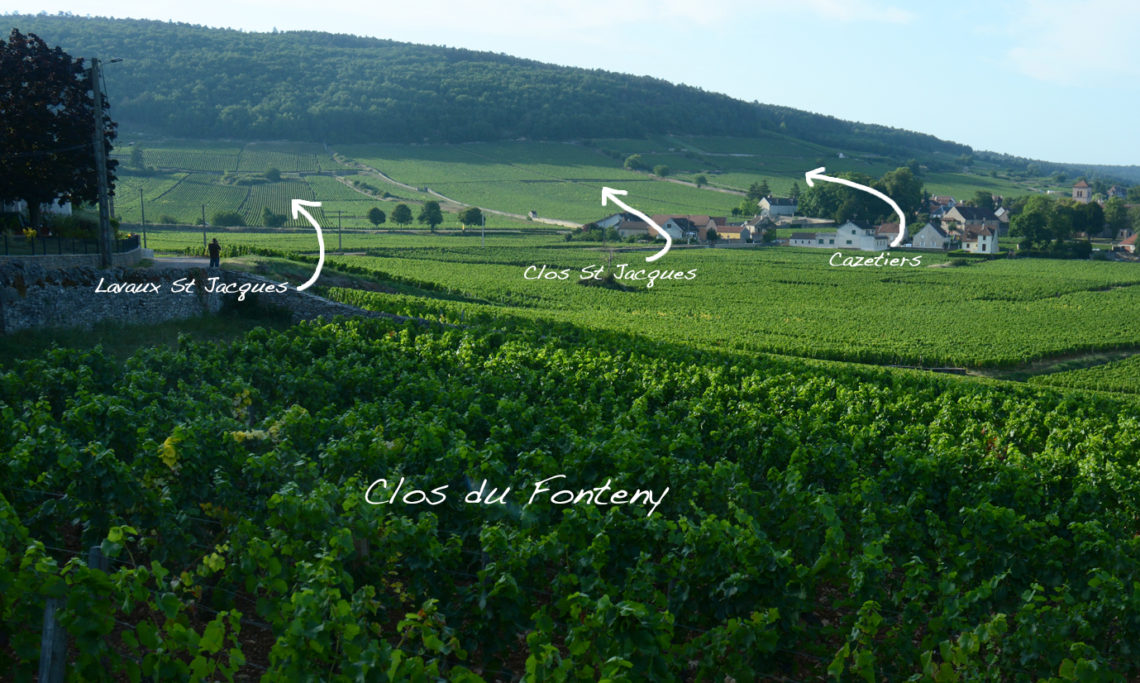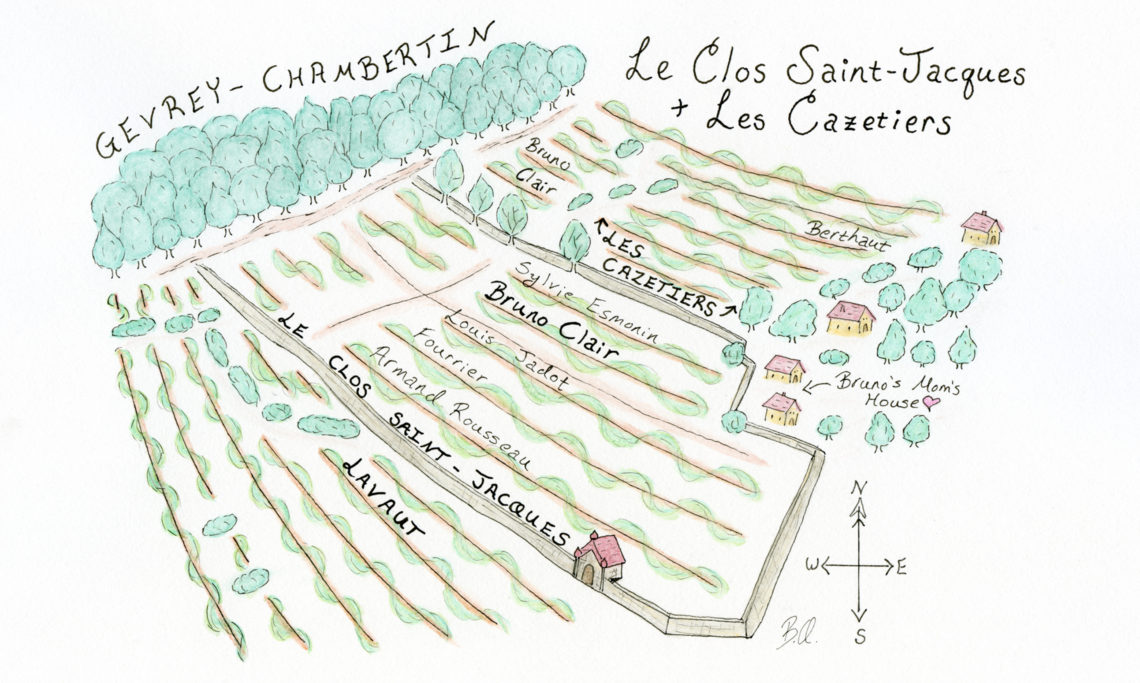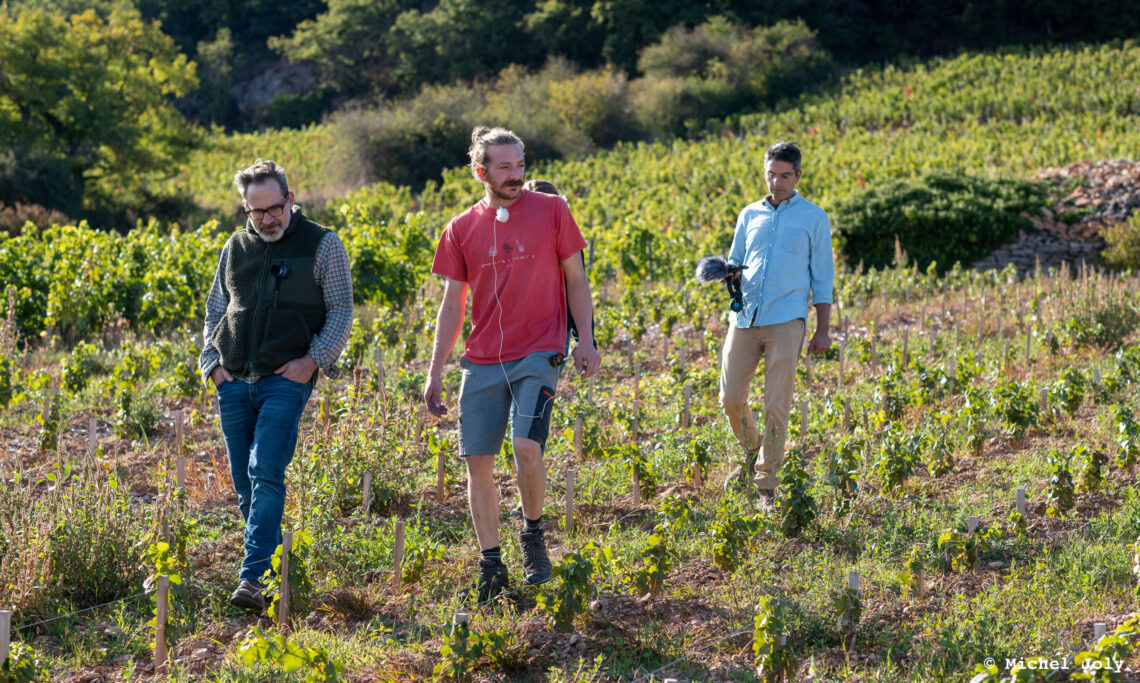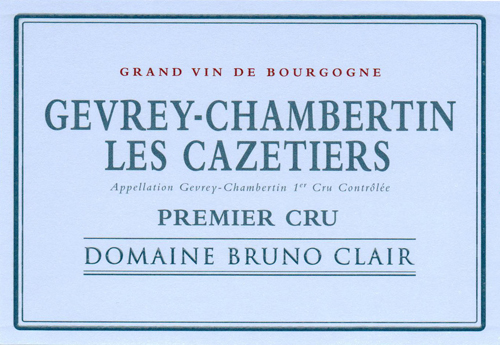Gevrey-Chambertin 1er Cru Les Cazetiers
At a Glance
- Size: 0.90 ha (2.20 ac)
- Variety: Pinot Noir
- Vine Age: Planted in 1958, 1972, and 1998
- Terroir: Next to Clos St. Jacques, east/southeast-facing, 325m average altitude, poor marl soil, limestone deposits.
- Viticulture: Sustainable, organic practices
- Vinification: 30-50% whole cluster, ambient yeast fermentation in open wood vats with punch-downs. Aged 18-20 months in barrels (approx. 35% new). Short blending period in tank before bottling.
Additional Info
Etymology:
“For a while, people mentioned a derivation of the word castel, in reference to the position of the climat above the castle of Gevrey-Chambertin. According to Françoise Dumas, the more plausible explanation is that Cazetiers was derived from cassis, which would indicate the presence of wild cassis or red currant bushes.” — Charlotte Fromont, La Côte de Nuits au Grand Jour
Site Description:
Les Cazetiers is an 8.43 ha vineyard, located directly upslope from the village of Gevrey, at 300 to 355 meters' elevation. This is a rather high elevation, the top of the vineyard being 50 meters higher than the top of Clos de Bèze, and 25 meters higher than the top of Vosne-Romanée les Reignots, for example.
Because Les Cazetiers is the northern neighbor of Clos-Saint-Jacques, it ought to be more famous. In fact, Bruno Clair, who owns both, prefers Les Cazetiers. (His cellarmaster, Philippe Brun, prefers Clos Saint Jacques. Their bickering about this and the comparative tastings in the cellar are always very entertaining.) However, the five owners of Clos Saint Jacques famously own sections of the vineyard that run the entire slope, making it one of the most consistent premier crus in the Côte d’Or. This is not the case with Les Cazetiers, where owners may have parcels anywhere on the slope, making the various examples heterogeneous.
Bruno Clair points out an interesting difference between Les Cazetiers and Clos Saint Jacques: In his cellar Les Cazetiers always has a higher pH (lower acidity). This translates into the flavors of the wines, with Cazetiers always feeling like blacker fruit, and Clos-Saint-Jacques like redder fruit.
Nevertheless, just after Clos-Saint-Jacques, Les Cazetiers and Les Combottes are the best premiers crus of Gevrey. Jasper Morris ranks Les Cazetiers as an exceptional premier cru, slightly higher than Les Combottes, which he ranks as an outstanding premier cru.
Soil:
The soil of Les Cazetiers is rich in heavy clay, as are the majority of the vineyards of Gevrey. It is rocky, with 45% to 20% gravels, cobbles, and even boulders, with the lower proportion at the bottom of the slope. At the top of the slope, the soil consists of stark white, completely decomposed marl, which the Burgundians call terres blanches. The soil becomes increasingly brown, to red brown as you go down the slope.
Bedrock:
At the very top there is a thin band of ostrea acuminata marl. It is followed by an equally thin band of Crinoidal limestone, itself followed by a thicker band of Premeaux limestone. This sandwich makes up a third to half of the upper slope.
The central part of the slope and most of the remaining vineyard is on Crinoidal limestone again. The exceptions to this are a triangle at southeast corner, which is on Premeaux and hydraulic limestones; and a band at the northeast corner, which is on soft, red, sandy marl.
The Bruno Clair parcel:
It is 0.87 ha with vines planted in thirds in 1958, 1972 and 1996. It is located in the southwest corner of the vineyard, at the top of the slope at 350 meters' elevation. It faces just slightly south of east.
Because of its location, it lies exclusively on stark white, completely decomposed marl, or terres blanches. Here, it has a very hard, cement-like quality, causing the vines to struggle. The topsoil is only about 10 cm deep and consists of up to 45% gravel and up to 10% cobbles. It is followed by a thick layer of laves, followed by a second layer of terres blanches soil before reaching the limestone bedrock.
The bedrock is ostrea acuminata marl and Crinoidal limestone, with perhaps a little of the Premeaux limestone.
Despite the fact that Les Cazetiers is more sheltered from the wind from the Combe de Lavaut than Clos Saint Jacques, Bruno says it systematically ripens one week later.
With many thanks to geologist Brenna Quigley for putting the physical and geological aspects of these vineyards into words far more meaningful than we could have written on our own. www.brennaquigley.com
We are also indebted to geologist Françoise Vannier of Adama Terroirs Viticoles, who created the bedrock map for Gevrey that Brenna based part her work on. www.adama-terroirs.fr
Wines
-
White
-
Rosé
-
Red
- Aloxe-Corton
- Chambolle-Musigny Les Véroilles
- Chambolle-Musigny 1er Cru Les Charmes
- Fixin Champs Perdrix
- Gevrey-Chambertin
- Gevrey-Chambertin 1er Cru Clos du Fonteny Monopole
- Gevrey-Chambertin 1er Cru Petite Chapelle
- Gevrey-Chambertin 1er Cru Les Cazetiers
- Gevrey-Chambertin 1er Cru Clos Saint-Jacques
- Marsannay Rouge
- Marsannay Les Vaudenelles
- Marsannay La Charme Aux Prêtres
- Marsannay Les Grasses Têtes
- Marsannay Les Longeroies
- Morey-Saint-Denis En La Rue De Vergy
- Savigny-les-Beaune 1er Cru Les Jarrons
- Savigny-les-Beaune 1er Cru La Dominode
- Vosne-Romanée Les Champs Perdrix
- Vosne-Romanée 1er Cru Aux Raignots
- Bonnes-Mares Grand Cru
- Chambertin Clos de Bèze Grand Cru




